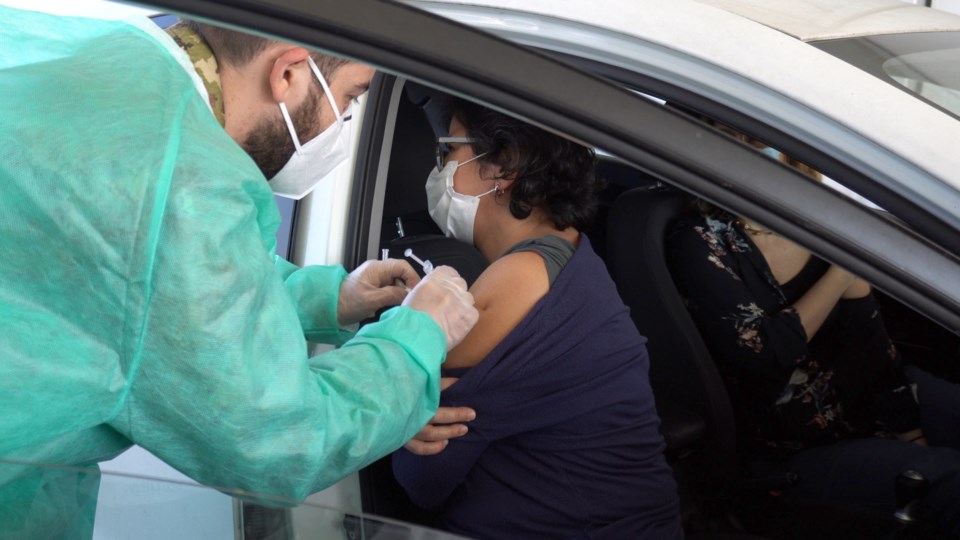Northern and Interior B.C. have a vaccination problem.
That means we now have a COVID-19 problem, again, and it’s going to get worse until we do better.
Interior Health Region has a lower vaccination rate than B.C. overall, 74.2 per cent of eligible people aged 12 and over with a first dose, compared to 80.9 per cent overall as of last Wednesday. Sixty per cent have received a second dose, compared to 63.2 per cent for B.C. overall.
So it’s not all that surprising that of the 185 new cases announced Wednesday, 113 were in the Interior. Compare that to Vancouver Coastal Health, which had 26.
The Northern Health region has an even worse vaccination rate, but has so far avoided the case count. That won’t last.
Next door in Alberta, rural vaccine hesitancy is being blamed but what’s that old saying: when you assume you make an ass of u and me.
Dr. Carol Fenton, medical health officer for Interior Health, has asked the province for the kind of qualitative study that would shed some light on what’s happening.
Until that’s done, Dr. Fenton says there are a number of possible reasons.
“One is that we did start vaccinating after some of the other areas in the province like Vancouver Coastal Health and Fraser Health. We did start a few weeks later than they did, so that's one possible factor,” she says.
“Another factor is that, geographically speaking, we have a much more challenging population to reach. The interior is really big, we have a lot more small and rural communities that we've had to circle back to a few times. That’s a unique challenge to the area.”
There are social and cultural factors at play when it comes to vaccine acceptance, she says.
“I don't have as much information as I would like about this. But I can say that historically, some of these communities have had really low vaccination rates for other vaccines as well. So it's not surprising to see.”
The First Nations community though, some of whom were actually subjected to medical experimentation on malnutrition in the darkest days of residential schools, are not necessarily among them.
With local involvement and oversight, and strong communication about the need to protect elders and youth, some First Nations communities have quite high vaccination rates.
Communities including Enderby, Kettle Valley and Creston, though, have rates as low as 60 per cent, Dr. Fenton points out.
Twenty- to 40-year-olds are driving the Interior infection rates right now, she says.
“Part of that is explained by the fact they were the last one of the last groups to get access to the vaccine,” she says.
If they have yet. I’m 48, and only received my second dose on July 8. And believe me, I had to be about first in line.
Dr. Fenton is more diplomatic than I am, so I’ll point out that the mask requirements and other public health measures were lifted provincewide before most young adults and teens – you know, the people who work a lot of retail and hospitality jobs – beyond the 604 were even eligible to be fully vaccinated.
A COVID-19 outbreak has been declared in the Central Okanagan, meaning a return of masks and other public health measures.
Dr. Fenton says Interior Health will maximize access to vaccines to get ahead of this.
“So that if someone were inclined to get vaccine, it's very easy,” she says.
There will be mobile vaccination clinics, drop-in appointments and strong promotion. Anyone who is not fully vaccinated should continue to wear a mask, wash their hands frequently and physically distance, she says.
“The masks were always still recommended for those who were not fully vaccinated, but as I'm sure you may have seen, they disappeared a lot faster than that,” Dr. Fenton says.
“And so I'm hoping this is a bit of a reminder that we can mandate them again, if people are not following the recommendations.”
Yes, there is vaccine hesitancy. Discounting or denigrating those who have concerns is not going to resolve it and maybe that’s important in a province struggling with a pharmaceutical industry-induced opioid epidemic.
I certainly hope Dr. Fenton’s suggestion for a proper study is realized.
Dene Moore is an award-winning journalist and writer. A news editor and reporter for The Canadian Press news agency for 16 years, Moore is now a freelance journalist living in the South Cariboo. Moore’s two decades in daily journalism took her as far afield as Kandahar as a war correspondent and the Innu communities of Labrador. She has worked in newsrooms in Vancouver, Montreal, Regina, Saskatoon, St. John’s and Edmonton. She has been published in the Globe and Mail, Maclean’s magazine, the New York Times and the Toronto Star, among others. She is a Habs fan and believes this is the year.
SWIM ON:
- From horse people to lemonade stands, Dene Moore thanked those who have stepped up to help those affected by wildfires.
- Dene Moore on one size fits all pandemic response: ‘There are two British Columbias, urban and rural. To ignore the divide is to increase it.’
- More Dene (Moore): The pandemic is expected to cause a massive shift towards working from home. For affordable, beautiful rural communities with more space than people, this could be a game-changer.



